This continuous streak is the first strong hint that there's nothing very
mysterious about this video, but there's much more.
Here are two images from the video above, with the brightness and contrast
enhanced to show the wings more clearly. (The upper image is the second
field in the sequence, which is on the right in the image above, and the
lower image is just before the "rod" reaches the clouds on the left.)
Note that the wings appear to have somehow shifted toward the "rod's" rear end!
How can that happen? Actually, it's easy to explain.
The image below is a section of the full sequence above, again with enhanced
brightness and contrast to show the wings more clearly.
Note that the wing spacing is fairly uniform across the entire sequence,
without respect to the "rod's" body in each field!
Given the shifting shown above, this would certainly be a remarkable coincidence if
this were really a "rod" with multiple wings.
This equal wing spacing is perhaps even more remarkable than the "coincidence" that
all "rods" seem to fly at precisely 60 times their own length per second:
Not only do "rods" fly at precisely the relative speed required to produce a
continuous streak when videographed at 60 fields per second, but they also
shift their wings so that they will appear to be equally spaced along that
continuous streak! These are indeed incredible creatures.
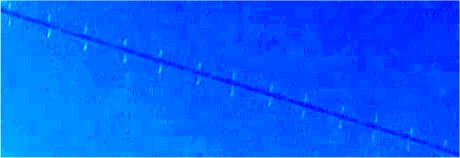
But this regular wing spacing is quite expected if all the wing images,
whether in a single image field or the next field, are simply caused by the
regular beating of ordinary insect wings, and we're only seeing the wings when
they were at the precise angle necessary to reflect light directly into the camera.
This also explains why the wings have been "shifted" on the two images
above: The wing flapping is very close to 120 beats per second (hence
the two wing images in each 1/60 second capture), but it's not exactly
120, and the slight difference means that wing images are not quite
synchronized with the 60 fields per second video capture. So, they are
not quite synchronized with the "rod" illusion, either, which causes the
wings to appear to be shifting on the "rod body" from one image to the next.
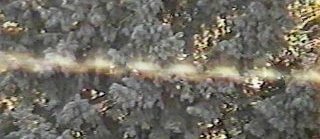 (To illustrate the "continuous streak
with equally spaced wings" effect, here is a composite of three frames of
a flying bug, which are also shown on the Rod's Sequence
page but with the center "rod" shown separately. Also see some of the "rod"
images below for exactly this same "coincidence".)
(To illustrate the "continuous streak
with equally spaced wings" effect, here is a composite of three frames of
a flying bug, which are also shown on the Rod's Sequence
page but with the center "rod" shown separately. Also see some of the "rod"
images below for exactly this same "coincidence".)
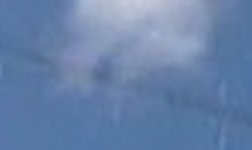 Several people (including Matt Twardy at Fox 23 who responded to my query,
and a videoanalyst named Brian Huff who submitted an analysis to the National
UFO Reporting Center, NUFORC, which is being touted on various UFOlogy
sites) have told me that they think this couldn't
possibly be a bug because it passes behind a cloud on the left, and the
clouds were at about 4000 feet. In a radio interview with Jerry Pippin, the Fox
camera man, Brandon Mowry, expressed the same opinion, and he said that this is
the reason that the Fox people discounted the "bug theory".
But I do believe that this is just an illusion caused by assuming that the
"rod" is a solid object when in fact it's mostly transparent, because it's
really a motion blur.
Seeing the cloud through the "rod" makes it look as if the "rod" passed behind
a semi-transparent cloud. But consider what happens if a bug is flying about
10 times its own length during the 1/60 second exposure time.
As the bug flies in front of the cloud, it would be blocking any given small
section of the cloud for only about 10% of the exposure time.
That is, the camera is "seeing" that piece of the cloud for 90% of the
exposure time, and the bug for the other 10%, which is to say that the
"rod" would be 90% transparent. (Actually, refraction around a small
roundish bug would increase the amount of cloud-reflected light reaching the
camera, so the streak would appear to be even more that 90% transparent.)
Several people (including Matt Twardy at Fox 23 who responded to my query,
and a videoanalyst named Brian Huff who submitted an analysis to the National
UFO Reporting Center, NUFORC, which is being touted on various UFOlogy
sites) have told me that they think this couldn't
possibly be a bug because it passes behind a cloud on the left, and the
clouds were at about 4000 feet. In a radio interview with Jerry Pippin, the Fox
camera man, Brandon Mowry, expressed the same opinion, and he said that this is
the reason that the Fox people discounted the "bug theory".
But I do believe that this is just an illusion caused by assuming that the
"rod" is a solid object when in fact it's mostly transparent, because it's
really a motion blur.
Seeing the cloud through the "rod" makes it look as if the "rod" passed behind
a semi-transparent cloud. But consider what happens if a bug is flying about
10 times its own length during the 1/60 second exposure time.
As the bug flies in front of the cloud, it would be blocking any given small
section of the cloud for only about 10% of the exposure time.
That is, the camera is "seeing" that piece of the cloud for 90% of the
exposure time, and the bug for the other 10%, which is to say that the
"rod" would be 90% transparent. (Actually, refraction around a small
roundish bug would increase the amount of cloud-reflected light reaching the
camera, so the streak would appear to be even more that 90% transparent.)
 To test this theory, I made this video of a small wad of black electrical tape
being dropped about 3 feet in front of a camcorder pointed at some clouds.
As expected, compositing all the fields produces a continuous streak,
but note that the blur is "washed out" where it passes in front of clouds,
especially in front of the brightest cloud.
You can still see it (and indeed, you can also see a faint streak on the
cloud in the Albany video, enlarged above), but basically, that little
wad of tape just isn't doing a very good job of blocking the camera's
view of the cloud in the frames were it passes in front of one.
Although the streak is still visible in these video captures,
when this video is viewed in slow motion (like the Albany video), there is a
fairly strong illusion that the "rod" flies behind the brightest cloud.
To test this theory, I made this video of a small wad of black electrical tape
being dropped about 3 feet in front of a camcorder pointed at some clouds.
As expected, compositing all the fields produces a continuous streak,
but note that the blur is "washed out" where it passes in front of clouds,
especially in front of the brightest cloud.
You can still see it (and indeed, you can also see a faint streak on the
cloud in the Albany video, enlarged above), but basically, that little
wad of tape just isn't doing a very good job of blocking the camera's
view of the cloud in the frames were it passes in front of one.
Although the streak is still visible in these video captures,
when this video is viewed in slow motion (like the Albany video), there is a
fairly strong illusion that the "rod" flies behind the brightest cloud.
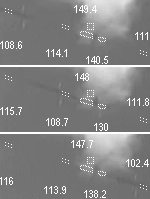 Update: Following a correspondence from "UFO picture analyst"
Dr. Bruce Maccabee, who has also done
an analysis of this video, I did this study of three consecutive images
reduced to gray-scale so as to show only relative brightness.
The objective here is to quantify the brightness of the "rod" relative to the sky
behind it, and to compare that to the relative brightness of the faint streak
where the "rod" crosses the cloud. The point is, if this streak is a motion blur
of a bug close to the camera, rather than something passing behind the cloud, then
the semi-transparent blur should dim the cloud by the same relative amount that it
dims the sky.
Update: Following a correspondence from "UFO picture analyst"
Dr. Bruce Maccabee, who has also done
an analysis of this video, I did this study of three consecutive images
reduced to gray-scale so as to show only relative brightness.
The objective here is to quantify the brightness of the "rod" relative to the sky
behind it, and to compare that to the relative brightness of the faint streak
where the "rod" crosses the cloud. The point is, if this streak is a motion blur
of a bug close to the camera, rather than something passing behind the cloud, then
the semi-transparent blur should dim the cloud by the same relative amount that it
dims the sky.
To study that question, this analysis identifies patches of "rod" pixels in each
of the three images and then locates the corresponding areas in the other two images.
The gray-scale values within each of these areas are then averaged and compared.
I've left these images at thier original size for the benefit of anyone wishing to
download and verify the numbers, but I actually worked with enlarged views for accuracy.
The top image is the field immediately after the field where the "rod's" path
intersects the cloud; the center image is the intersection with the cloud;
and the lower image is the field immediately before the intersection.
Starting with the center image, I outlined with white dots the two small patches
of cloud along the "rods" path, i.e. where the object either passed in front
of or behind the cloud. Together, these two patches total 53 pixels.
Using several other patches of cloud edges to aid alignment,
I transferred these dotted outlines to the other two images,
and I took great care to insure that the alignment was as good as possible.
Then, in each of the three images, I outlined a small patch (14 pixels) of "rod body"
image, and using the first outline dots as reference points, transferred the
"rod" outline dots to each of the other images. Also, on the cloud immediately
above the path of the "rod", I've outlined a 25-pixel square on all three images,
for comparison purposes. (These should be the same brightness in all three images,
with any difference being attributable to "noise".)
Then, I've simply added up and averaged the pixel values in each region
(with the two cloud patches along the path taken together), to get an average
brightness value for each region. This averaging (and the subsequent comparison
to the "average of the averages" in two other images) is an attempt to get
reasonably meaningful brightness values, even though there is a fair amount of
"noise" in any CCD image. The numbers show those averages. (Note that the
two irregular patches immediately at the cloud were added together and
averaged to get the numbers 140.5, 130, and 138.2, which is why there are
only five sets of number for the six patches.)
Now, if we compare the small "rod" section in the upper left of the top
image to the average of the values in the other two images, we see that
the "body of the rod" is actually only about 6.3% dimmer than the blue
sky in the other images. Similarly, the "rod" section in the lower right
of the bottom image is about 8.1% dimmer than the corresponding sky in
the other two images. The "rod" section immediately to the left of the
cloud in the center image is about 4.7% dimmer than the sky in the other
two images, and finally, the cloud patches where the "rod's" path
intersects it are about 6.7% dimmer than the corresponding patches of
the other two images, while the comparison square immediately above
the path is roughly the same. That is, even though the dimming is barely
perceptable to the human eye, the cloud in the "rod's" path has been
dimmed about the same amount, relatively, as the blue sky in the same image.
(Note that I'm showing one decimal place of precision here, but I don't
really mean to imply that the measurements can be considered to be that
accurate; the noise level is large enough that these numbers should
only be taken as rough approximations of the true values, as indicated
by differences in areas that ought to be the same, but note that the
loss of brightness along the path of the object is well above the noise
level.)
In other words, this loss of brightness where the "rod's" path crosses
the cloud is roughly comparable to the "rod" vs. sky dimming seen in all
the images. This relative dimming is completely consistent with the hypothesis
that the object passed in front of the cloud, but it would seem to be
difficult to explain if the object flew behind the cloud.
Moreover, the percentage of dimming in both cases is approximately the
"transparency" value that would be expected for a completely black bug flying
about 12 to 14 times its own length in each field, or if the bug were not
completely black (and allowing for a small amount of refraction around the bug),
then something less than 14 times its own length. And that number
is reasonably consistent with the apparent size of the "rod" if we assume
it's really a bug, and is also not an unreasonable speed for an ordinary
flying bug. For example, this could be a bug about a half-inch long making
six-inch-long streaks, which would only require a speed of about 20 MPH.
(Of course, there isn't any way to tell the true length or speed of the "rod"
from this video, so those number are only intended to illustrate the
point that the hypothesis is reasonable. A bug an inch long and flying at 40 MPH
would make foot-long streaks, for example, with the same relative transparency.)
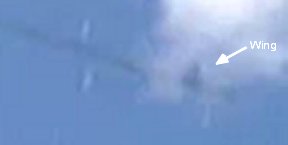 Also, Dr. Maccabee points out another piece of evidence in this image
(although he doesn't seem to pursue it very far): There appears to
actually be a 4th wing in the image, where that wing should have been blocked
by the cloud if the object passed behind the cloud. Furthermore, it's about
the same brightness as the other three wings in that same image.
Also, Dr. Maccabee points out another piece of evidence in this image
(although he doesn't seem to pursue it very far): There appears to
actually be a 4th wing in the image, where that wing should have been blocked
by the cloud if the object passed behind the cloud. Furthermore, it's about
the same brightness as the other three wings in that same image.
What we have here, on the one hand, is two direct pieces of evidence that the
object passed in front of the cloud, and on the other hand, apparently nothing
but a "perception" on the part of many people that it passed behind the cloud.
And in that regard, it's worth noting that the two pieces of evidence are not
immediately obvious, because the human eye is not really very good at
measuring absolute brightness.
 Here's another "rod" video that's also quickly becoming famous, from Fox News
cable. I got a lot of e-mail about this one, and apparently so did Escamilla.
It's a night shot of Baghdad, aired on April 3, 2003, at about 4:00pm EST.
This image is from
Jeff Rense's site. (I have slightly reduced the size.)
Unfortunately, there doesn't appear to be a sequential set of video fields
there, although two of the images may
be from sequential frames, thus showing a "rod-length gap" between the two,
but it isn't clear if that's the case.
Here's another "rod" video that's also quickly becoming famous, from Fox News
cable. I got a lot of e-mail about this one, and apparently so did Escamilla.
It's a night shot of Baghdad, aired on April 3, 2003, at about 4:00pm EST.
This image is from
Jeff Rense's site. (I have slightly reduced the size.)
Unfortunately, there doesn't appear to be a sequential set of video fields
there, although two of the images may
be from sequential frames, thus showing a "rod-length gap" between the two,
but it isn't clear if that's the case.
But I have found one site,
"Coast to Coast AM", that has some images posted by "Steve W."
These are apparently digital camera pictures of a TV monitor playing a tape of
the "rods". The picture on the left appears to be the same video field as the
image above, and the one on the right appears to be the field either before or
after that one.

By now, it should come as no surprise that when we composite the two images,
we get a continuous streak, and again we see that the wing images are
equally spaced across the streak. A remarkable coincidence, don't you think?

The following two sequences were taken from videos featured on Korean TV MBC News.
(The composite images are the size of the original captures, whereas the sequences
on the left have been reduced in size.) Like the videos above,
these sequences apparently include both fields from each frame, so the composited
"rod" is a continuous motion-blurred streak. Also like the Albany and Baghdad images
above, in the first sequence here, we can see that the wing spacing is very regular
across the entire sequence, which is exactly what we would expect for a pair
of insect wings that were beating at a constant frequency across the entire
sequence. The images appear to be of multiple wings because we only see the
shiny wings when they are at the angle necessary to reflect light into the camera.

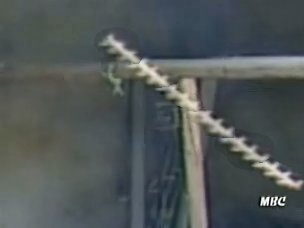

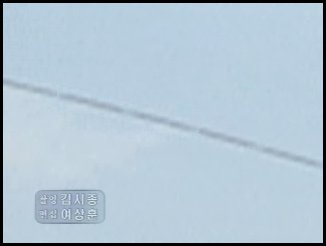
Here are some "rod" sequences from "UFO photographer" John Bro.
The site where I originally found these images has disappeared or perhaps been
moved, and I cannot find a link now. In each case, I have shown the original
sequence reduced in size, to save space, but the composites are the size of
the originals.
The first sequence shows the typical "two rod-lengths per frame" apparent speed,
like most of Escamilla's video captures. And again, it seems the best
explanation is that, although each field was captured in 1/60 second with
1/60 second exposure time, we are only seeing one field from each frame, and
the gaps would be "rods" in the unshown fields.

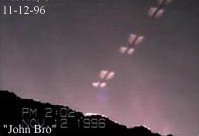
The next sequence seems to show three consecutive fields, so there is no gap
between the "rods" when composited. The sequence following that one appears to be
an incomplete set: One field is apparently missing, so there is one gap,
but farther along the sequence, the images form a continuous streak.
Note that, like the sequence at the top of this page, the wing patterns in
both of these sequences are equally spaced in the composited image,
and the best explanation is that we are simply seeing the regular beating of
an ordinary pair of insect wings.

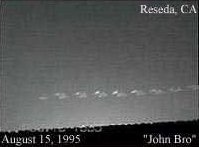

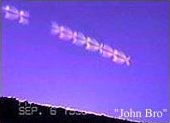
This is a sequence by Michael Merchant that was published (along with other
single images) on Art Bell's site under the title "New Rods Study". Since then,
Michael has come to the conclusion that "rods" are insects. When I first contacted
Michael, he was already looking at some bee pictures shot at slow shutter speeds
that looked exactly like the best "winged rod" images, and I hope that this
composited image and my explanation of the tell-tale "two rod-lengths per frame"
pattern was of some use to him in reaching his final conclusion.
Michael's most recent article at
www.flyingrods.com
is titled "The Rod Mystery Solved".
It is extremely rare for someone to go from believer to skeptic on the
weight of the evidence. Most believers actively avoid that by ignoring the evidence.
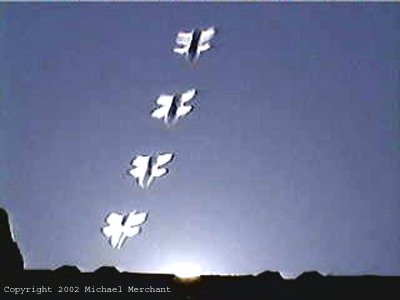
The following pictures were taken from Japanese sites, which Jose Escamilla posted
on his discussion board after a special on "rods" appeared on Japanese TV.
Unfortunately, these sites appear to be no longer available.
It seems that Japanese "rods" also move at a rate of
about twice their own length per video frame !
The first picture was already composited from a sequence, so I have used that one
"as is". (There was also an animated GIF of the same sequence on the site.)
The other two were composited from pictures that were actually
found on different pages, but the time-stamps on the pictures show that
these are two sequences, two images each from two videos.
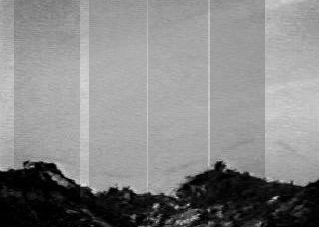
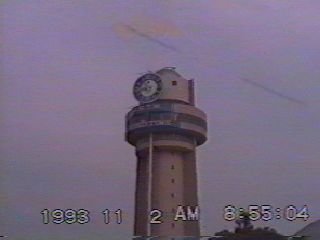
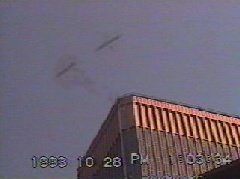

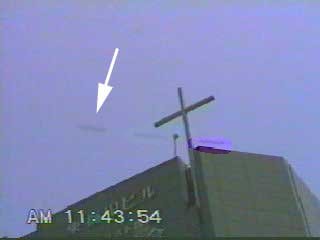
From two videos by an Italian TV station.
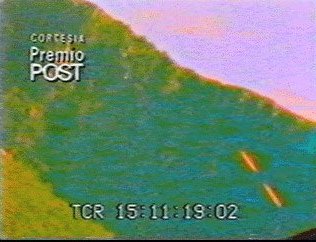
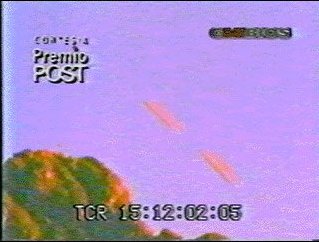
These two pictures were composited from animated GIF files found on
another site that is no longer available.
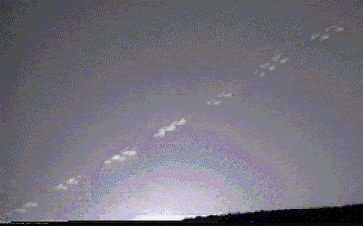
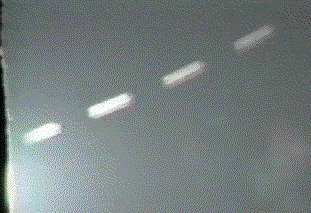
This image was composited from an AVI video found on another site that is no longer available.
Again, using all of the fields, we get a continuous streak with the wing images equally spaced.

Here are two sequences from a "special report" by KCOP Channel 13 News (Los Angeles),
which sent cameramen and Escamilla back to the Cave of the Swallows to get some
more videos. Apparently, we have only one field from each frame, so we get the "rod-gap-rod"
pattern.
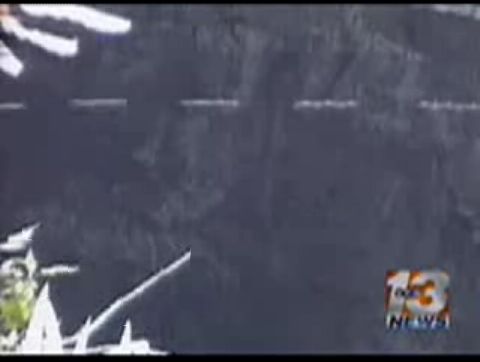
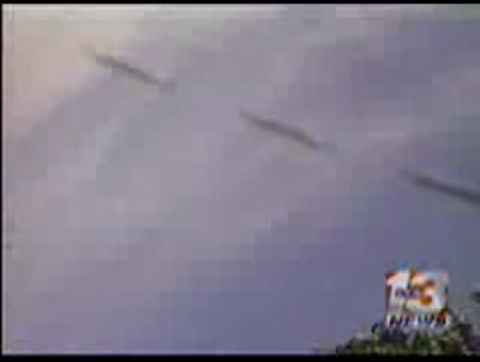
(Quote from the reporter: "But how do we know they aren't just insects, or lens flares, or something else?
Escamilla says the evidence is just too compelling." And if you don't find that
"compelling" enough, Escamilla ices it, "You just can't say, there's no such thing,
you know, because before you know it, it's gonna slap you in the face and there it is.")
Update February 2010: Ten Years After
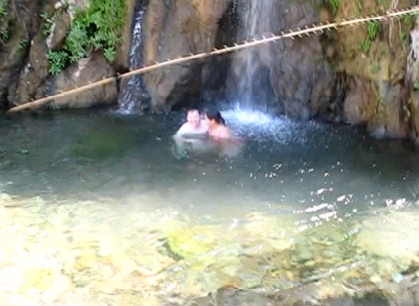 It's hard to believe it's been 10 years since I started posting
some results of my "rods" study and experiments on Jose Escamilla's forum and started this website.
But it's not surprising, I guess, that some things never change: Escamilla still has his
roswellrods.com website online, where he encourages
"researchers" to post their own videos (like
this one,
from which I made the composite at right), while still refusing to inform them that there's
nothing particularly mysterious about bugs flying near cameras.
Surely, Escamilla knows what a composited image would show, and surely a serious researcher
would warn fellow researchers to try that test so they wouldn't be deluding themselves
with videos that are easily explained.
Could it be that he is worried that mentioning that test would make it even harder to solicit
contributions to finance "Roswell Rods - The Movie"?
($2000 will get you a "Producer" credit, but if that's too steep,
$50 earns a "Special Thanks." That effort must not be going too well, anyway, since after
several years of soliciting, all he has is a trailer.)
It's hard to believe it's been 10 years since I started posting
some results of my "rods" study and experiments on Jose Escamilla's forum and started this website.
But it's not surprising, I guess, that some things never change: Escamilla still has his
roswellrods.com website online, where he encourages
"researchers" to post their own videos (like
this one,
from which I made the composite at right), while still refusing to inform them that there's
nothing particularly mysterious about bugs flying near cameras.
Surely, Escamilla knows what a composited image would show, and surely a serious researcher
would warn fellow researchers to try that test so they wouldn't be deluding themselves
with videos that are easily explained.
Could it be that he is worried that mentioning that test would make it even harder to solicit
contributions to finance "Roswell Rods - The Movie"?
($2000 will get you a "Producer" credit, but if that's too steep,
$50 earns a "Special Thanks." That effort must not be going too well, anyway, since after
several years of soliciting, all he has is a trailer.)
Escamilla still claims on his home page that exploring his site will reveal the conclusive
evidence that "rods" are not bugs. However, the site seems to contain less and less actual
content every time I visit it, except for the slowly growing pile of visitor contributions,
but sadly none of those videos deliver the promised evidence.
For some unexplained reason, he has yet to produce the one thing that would be convincing: the
"high speed" videos that he's been promising for over 10 years, which would prove once and for all
that at least some "rods" aren't motion-blurred bugs.
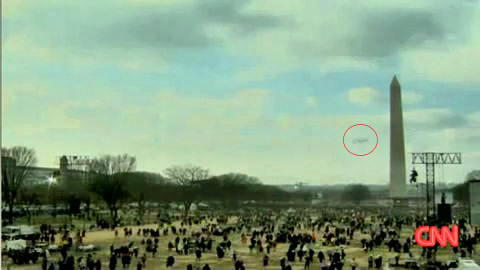 And I guess it's not surprising that some "rods" videos still create a minor stir
(at least among people who haven't seen or heard of "rods" before),
usually because they are pegged as "UFOs"
(which they are, of course, but only to those who can't identify them).
The reason for this update is that someone recently brought to my attention one such video:
this clip
from CNN's coverage of President Obama's inauguration last year.
(Here
is an example of the studious analysis it provoked.)
And I guess it's not surprising that some "rods" videos still create a minor stir
(at least among people who haven't seen or heard of "rods" before),
usually because they are pegged as "UFOs"
(which they are, of course, but only to those who can't identify them).
The reason for this update is that someone recently brought to my attention one such video:
this clip
from CNN's coverage of President Obama's inauguration last year.
(Here
is an example of the studious analysis it provoked.)
 But if you understand what I've been saying on this site for the last 10 years,
then this nine-frame, slightly enlarged and contrast-enhanced composite should be as unsurprising to you as it is to me.
But if you understand what I've been saying on this site for the last 10 years,
then this nine-frame, slightly enlarged and contrast-enhanced composite should be as unsurprising to you as it is to me.
So again and again, in virtually every video that can be found on the Web that shows
a sequence of consecutive fields or frames, we see the same patterns when we put the
consecutive images together: "Rods" either from a continuous streak (if all the fields
are used) or they form a pattern of "rods" separated by gaps of the same length
(if only one field from each frame is used).
It's very hard to avoid the obvious conclusion.
Comments, questions, or copyright lawsuits about this page?
Contact Sol
Please read these pages for more evidence:
Jose Escamilla "Rod" Sequence Pictures
More Flying Bug Sequence Pictures
More Escamilla "Rods"
Conclusion
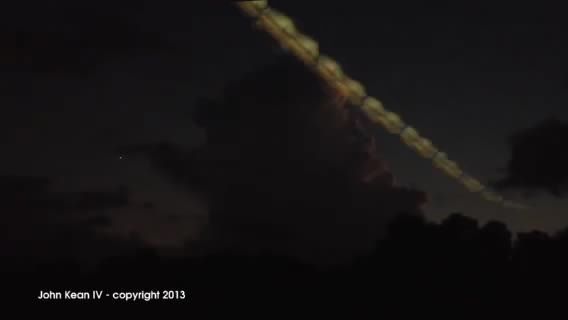
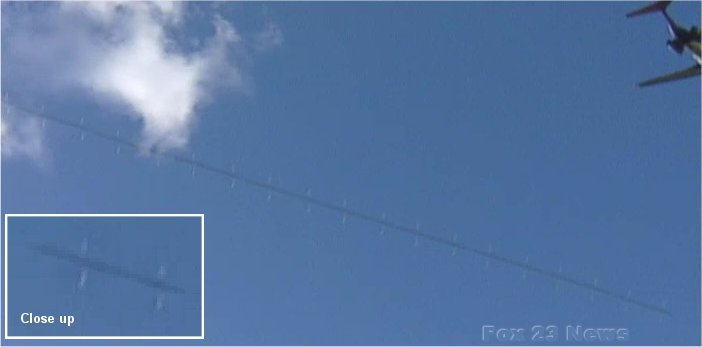

 (To illustrate the "continuous streak
with equally spaced wings" effect, here is a composite of three frames of
a flying bug, which are also shown on the Rod's Sequence
page but with the center "rod" shown separately. Also see some of the "rod"
images below for exactly this same "coincidence".)
(To illustrate the "continuous streak
with equally spaced wings" effect, here is a composite of three frames of
a flying bug, which are also shown on the Rod's Sequence
page but with the center "rod" shown separately. Also see some of the "rod"
images below for exactly this same "coincidence".) Several people (including Matt Twardy at Fox 23 who responded to my query,
and a videoanalyst named Brian Huff who submitted an analysis to the National
UFO Reporting Center, NUFORC, which is being touted on various UFOlogy
sites) have told me that they think this couldn't
possibly be a bug because it passes behind a cloud on the left, and the
clouds were at about 4000 feet. In a radio interview with Jerry Pippin, the Fox
camera man, Brandon Mowry, expressed the same opinion, and he said that this is
the reason that the Fox people discounted the "bug theory".
But I do believe that this is just an illusion caused by assuming that the
"rod" is a solid object when in fact it's mostly transparent, because it's
really a motion blur.
Seeing the cloud through the "rod" makes it look as if the "rod" passed behind
a semi-transparent cloud. But consider what happens if a bug is flying about
10 times its own length during the 1/60 second exposure time.
As the bug flies in front of the cloud, it would be blocking any given small
section of the cloud for only about 10% of the exposure time.
That is, the camera is "seeing" that piece of the cloud for 90% of the
exposure time, and the bug for the other 10%, which is to say that the
"rod" would be 90% transparent. (Actually, refraction around a small
roundish bug would increase the amount of cloud-reflected light reaching the
camera, so the streak would appear to be even more that 90% transparent.)
Several people (including Matt Twardy at Fox 23 who responded to my query,
and a videoanalyst named Brian Huff who submitted an analysis to the National
UFO Reporting Center, NUFORC, which is being touted on various UFOlogy
sites) have told me that they think this couldn't
possibly be a bug because it passes behind a cloud on the left, and the
clouds were at about 4000 feet. In a radio interview with Jerry Pippin, the Fox
camera man, Brandon Mowry, expressed the same opinion, and he said that this is
the reason that the Fox people discounted the "bug theory".
But I do believe that this is just an illusion caused by assuming that the
"rod" is a solid object when in fact it's mostly transparent, because it's
really a motion blur.
Seeing the cloud through the "rod" makes it look as if the "rod" passed behind
a semi-transparent cloud. But consider what happens if a bug is flying about
10 times its own length during the 1/60 second exposure time.
As the bug flies in front of the cloud, it would be blocking any given small
section of the cloud for only about 10% of the exposure time.
That is, the camera is "seeing" that piece of the cloud for 90% of the
exposure time, and the bug for the other 10%, which is to say that the
"rod" would be 90% transparent. (Actually, refraction around a small
roundish bug would increase the amount of cloud-reflected light reaching the
camera, so the streak would appear to be even more that 90% transparent.)
 To test this theory, I made this video of a small wad of black electrical tape
being dropped about 3 feet in front of a camcorder pointed at some clouds.
As expected, compositing all the fields produces a continuous streak,
but note that the blur is "washed out" where it passes in front of clouds,
especially in front of the brightest cloud.
You can still see it (and indeed, you can also see a faint streak on the
cloud in the Albany video, enlarged above), but basically, that little
wad of tape just isn't doing a very good job of blocking the camera's
view of the cloud in the frames were it passes in front of one.
Although the streak is still visible in these video captures,
when this video is viewed in slow motion (like the Albany video), there is a
fairly strong illusion that the "rod" flies behind the brightest cloud.
To test this theory, I made this video of a small wad of black electrical tape
being dropped about 3 feet in front of a camcorder pointed at some clouds.
As expected, compositing all the fields produces a continuous streak,
but note that the blur is "washed out" where it passes in front of clouds,
especially in front of the brightest cloud.
You can still see it (and indeed, you can also see a faint streak on the
cloud in the Albany video, enlarged above), but basically, that little
wad of tape just isn't doing a very good job of blocking the camera's
view of the cloud in the frames were it passes in front of one.
Although the streak is still visible in these video captures,
when this video is viewed in slow motion (like the Albany video), there is a
fairly strong illusion that the "rod" flies behind the brightest cloud.
 Update: Following a correspondence from "UFO picture analyst"
Dr. Bruce Maccabee, who has also done
Update: Following a correspondence from "UFO picture analyst"
Dr. Bruce Maccabee, who has also done
 Also, Dr. Maccabee points out another piece of evidence in this image
(although he doesn't seem to pursue it very far): There appears to
actually be a 4th wing in the image, where that wing should have been blocked
by the cloud if the object passed behind the cloud. Furthermore, it's about
the same brightness as the other three wings in that same image.
Also, Dr. Maccabee points out another piece of evidence in this image
(although he doesn't seem to pursue it very far): There appears to
actually be a 4th wing in the image, where that wing should have been blocked
by the cloud if the object passed behind the cloud. Furthermore, it's about
the same brightness as the other three wings in that same image.
 Here's another "rod" video that's also quickly becoming famous, from Fox News
cable. I got a lot of e-mail about this one, and apparently so did Escamilla.
It's a night shot of Baghdad, aired on April 3, 2003, at about 4:00pm EST.
This image is from
Here's another "rod" video that's also quickly becoming famous, from Fox News
cable. I got a lot of e-mail about this one, and apparently so did Escamilla.
It's a night shot of Baghdad, aired on April 3, 2003, at about 4:00pm EST.
This image is from 
























 It's hard to believe it's been 10 years since I started posting
some results of my "rods" study and experiments on Jose Escamilla's forum and started this website.
But it's not surprising, I guess, that some things never change: Escamilla still has his
It's hard to believe it's been 10 years since I started posting
some results of my "rods" study and experiments on Jose Escamilla's forum and started this website.
But it's not surprising, I guess, that some things never change: Escamilla still has his
 And I guess it's not surprising that some "rods" videos still create a minor stir
(at least among people who haven't seen or heard of "rods" before),
usually because they are pegged as "UFOs"
(which they are, of course, but only to those who can't identify them).
The reason for this update is that someone recently brought to my attention one such video:
And I guess it's not surprising that some "rods" videos still create a minor stir
(at least among people who haven't seen or heard of "rods" before),
usually because they are pegged as "UFOs"
(which they are, of course, but only to those who can't identify them).
The reason for this update is that someone recently brought to my attention one such video:
 But if you understand what I've been saying on this site for the last 10 years,
then this nine-frame, slightly enlarged and contrast-enhanced composite should be as unsurprising to you as it is to me.
But if you understand what I've been saying on this site for the last 10 years,
then this nine-frame, slightly enlarged and contrast-enhanced composite should be as unsurprising to you as it is to me.